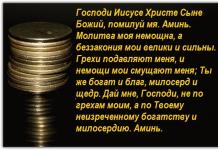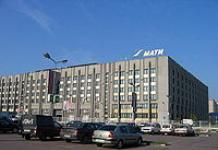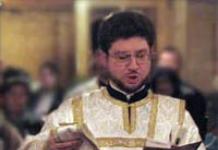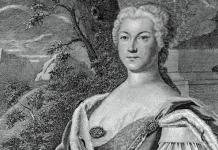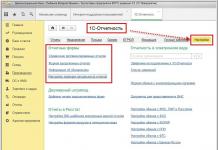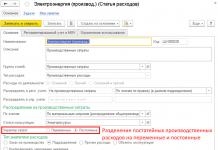And Stalin’s anti-Semitism, which can be read about in almost all his biographies, was neither religious, nor ethnic, nor everyday. It was political and manifested itself in the form of anti-Zionism, not Judeophobia. In Georgia, where Stalin grew up, there were no Jewish ghettos, and the Georgian Jewish diaspora was assimilated into Georgian culture. Jews have lived in Georgia for centuries. They appeared in Transcaucasia from Palestine and Persia, and not from Europe, spoke Georgian and had Georgian names. Stalin's anti-Zionism manifested itself most noticeably after the war, when the “Jewish question” became a pressing international problem. The social and legal situation of Russian Jews radically improved precisely after the October Revolution. This was primarily facilitated by the abolition of the Jewish Pale of Settlement and the support of socialist ideals by the Jewish intelligentsia. However, the USSR was an anti-religious state, and therefore Jewish religious communities continued to be oppressed, but no more than Orthodox, Muslim or Catholic ones. Buddhism was completely banned. In the USSR there were no days off or holidays tied to any religious holidays, and not only Christmas and Easter, traditionally celebrated in Russia, were considered working days, but the seven-day week was also abolished in the 20s and 30s - until 1936 of the year. Factories, factories, schools and other institutions worked on a six-day basis, five working days and the sixth day off. This provided two days off at the end of those months, which totaled 31 days. All these anti-religious and calendar reforms were carried out during the “Leninist” period of Soviet power, that is, until 1924. Anti-religious decrees peaked in 1921, coinciding with the onset of famine, more liberal economic policies (NEP) and the end of the Civil War. Islam and Judaism are more difficult to coexist with the communist regime than Orthodox Christianity, since they are associated with a large number of ritual obligations and contain elements of legislation. The legalization of the church, carried out by Stalin in 1943, concerned only the Orthodox religion and did not apply to Islam, Judaism and Catholicism. During and after the war, particularly brutal repression fell on the Muslim peoples of the Caucasus and Crimea and on the Catholic communities in Estonia, Latvia, Lithuania and Western Ukraine. State anti-Semitism was hidden and disguised as a fight against cosmopolitanism. It arose as the inevitable reaction of the authorities to the growth of Jewish nationalism that arose as a result of the Nazi genocide of the Jews. It was the extermination of Jews in Europe, carried out with a cruelty unprecedented in the history of civilizations, that led to the need to create an independent Jewish state. This was possible after the war only on the territory of Palestine, which did not have international legal status even in 1945. The Crimean JAC project could not be an alternative, since the creation of a truly independent Jewish state on the territory of the USSR was impossible.
The political nature of Stalin's attitude to Jewish problems is obvious from the fact that he showed himself to be an active supporter of the creation of the state of Israel. One can say even more - without Stalin’s support for the project of creating a Jewish state on the territory of Palestine, this state could not have been created in 1948. Since Israel could actually appear only in 1948, since it was at that time that the British mandate to govern this territory ended, Stalin’s decision, directed against Great Britain and its Arab allies, was of historical significance.
Until 1918, Palestine was part of the Ottoman Empire, and the establishment of Jewish settlements in Palestine, financed by Zionist organizations, was extremely difficult. After the defeat of the Central Powers in the First World War and the collapse of the two empires, Austrian and Ottoman, a large number of new states were formed, the borders of which, often very arbitrarily, were determined by the victorious countries. Palestine remained simply a “territory”, the mandate for which the newly created League of Nations handed over to Great Britain. In 1919, 568,000 Muslim Arabs, 74,000 Christians and 58,000 Jews lived in this territory. The British government, unlike the Turkish Sultan, did not prohibit the immigration of Jewish settlers, but introduced a strict quota of no more than 10 thousand people per year. The Arabs strongly opposed the settlement of Palestine by Jews, and the entire period of the British mandate for this territory was full of conflicts between the Arab and Jewish populations. During World War II, illegal Jewish immigration to Palestine increased sharply. These were mainly refugees from Europe and North Africa, where battles were taking place between the German and British armies. Constant conflicts between armed groups of Jews and British garrisons became commonplace. By 1946, Britain could not maintain stability in Palestine and decided to abandon its mandate. By February 1947, when the United Nations Special Commission on Palestine was created, there were 1,091,000 Muslim Arabs, 614,000 Jews and 146,000 Christians living in the Mandate Territory.
The problem of Palestine turned out to be very difficult for the UN. Britain, whose mandate expired in May 1948, insisted on the creation of a single multi-ethnic Palestinian state. Based on this principle, the neighboring independent republic of Lebanon was created in 1943, which was also governed by France since 1919 under the mandate of the League of Nations. In Lebanon in 1943, Christians, Greek Orthodox, Armenians and Maronites made up slightly less than half the population, about 7 percent were Druze, and the rest were Muslim, Shia and Sunni in roughly equal proportions. Other UN members, taking into account the conflictual relations between Arabs and Jews, proposed the creation of a federal state similar to Yugoslavia or Switzerland. This project was difficult to implement, since the three main religious and ethnic groups in Palestine did not have sufficiently isolated territories and were mixed.
The third project, which was supported primarily by the USA and the USSR, envisaged the division of Palestine into two independent states - Palestinian and Jewish. The Jewish state could include areas with a predominant Jewish population centered in Tel Aviv, while most of the remaining territory would become part of the Palestinian Arab state. Jerusalem was supposed to be declared an “open city” under international control. It was impossible to discuss the problem of Palestine in the UN Security Council, since Great Britain had a veto in this case. A solution to the problem could only be achieved by voting at the plenary session of the UN General Assembly. To prepare the draft for voting, a special commission on Palestine was created. This commission, which worked for several months, recommended for voting at the UN exactly the two-state project, which was supported primarily by the USA and the USSR. Great Britain and all Arab and Muslim countries were against it. The main difficulty in adopting the recommended draft was that, according to the UN Charter, not a simple majority, but two-thirds of the countries that were members of the UN had to vote for it. Under these conditions, the position of the USSR, that is, Stalin, was critical. Stalin practically controlled the votes of five UN member countries: the USSR, the Ukrainian SSR, the Byelorussian SSR, Czechoslovakia and Poland. In 1947, the UN had only 60 members. Countries considered aggressors in the recently ended war - Germany, Japan, Austria, Romania, Hungary and some others - have not yet been admitted to the UN. Most of the African and almost half of the Asian countries were still classified as colonies.
The second session of the UN General Assembly, which opened in September 1947, took over the duties of the provisional committee on Palestine and discussed all aspects of the problem in great detail, hearing not only the report of the subcommittee, which included the USA and the USSR, but also the subcommittee of Muslim countries. The atmosphere of the discussion before the preliminary vote on November 25, 1947 was very tense. 25 countries voted in favor of creating two independent states in Palestine, 13 countries opposed the project and 17 countries, including Great Britain and Yugoslavia, abstained. Yugoslavia, although part of the Soviet bloc in 1947, supported the idea of a federal Palestine. The USSR, Ukraine, Belarus, Czechoslovakia and Poland supported the plan to divide Palestine into two independent states.
But one vote was missing for a two-thirds qualified majority. Delegations from the Philippines and Paraguay did not attend the UN Assembly. These countries were US satellites in 1947, and their representatives were rushed to New York. The too many abstentions were also a disappointment for Jewish and Zionist organizations. Even a two-thirds majority with 27 votes from the 57 countries that took part in the General Assembly still provided a very weak mandate. Discussion and intense lobbying were intense in the days leading up to the final vote on November 29, 1947.
The chairman of the Soviet delegation at this UN session was Andrei Gromyko, the first permanent representative of the USSR to the UN. In Moscow, at the Foreign Ministry, supervision of the work of the Soviet delegation to the UN was carried out mainly by Andrei Vyshinsky, formerly the Prosecutor General, and since 1946, Deputy Minister of Foreign Affairs of the USSR. Vyshinsky, in turn, received instructions not so much from Molotov as from Stalin, with whom he had friendly ties dating back to the period 1908-1909, when they were both serving sentences in the prison fortress in Baku for revolutionary activities - Stalin as a Bolshevik, Vyshinsky like a Menshevik. It is appropriate to cite excerpts from Gromyko’s speeches so that the arguments of the Soviet delegation are clear. Before the preliminary vote, Gromyko spoke in general terms:
“The essence of the problem is the right to self-determination of the hundreds of thousands of Jews and also Arabs living in Palestine... their right to live in peace and independence in their own states. We must take into account the suffering of the Jewish people, which None of the states of Western Europe was able to defame during the period of their struggle against Hitlerism and with Hitler’s allies in protecting their rights and their existence... The UN must help every people to obtain the right to independence and self-determination ..."
“...The experience of studying the question of Palestine has shown that Jews and Arabs in Palestine do not want or cannot live together. This led to the logical conclusion: if these two peoples inhabiting Palestine, both having deep historical roots in this country, cannot live together within a single state, then there is nothing else left to do but to form two states instead of one - Arab and Jewish. In the opinion of the Soviet delegation, no other practically feasible option can be thought of...”
In the decisive vote of the UN General Assembly, 33 countries supported the resolution establishing independent Arab and Jewish states; Thirteen countries voted against the draft, and the number of abstentions was reduced to 10. Five Soviet bloc countries provided the required two-thirds majority. If these countries had supported the Arab position, the pro-con ratio would have been 28 to 18. This would not have provided a two-thirds majority, and therefore the creation of Israel would not have received a UN mandate. Muslim countries were against the creation of Israel in this vote; Afghanistan, Egypt, Iran, Iraq, Lebanon, Pakistan, Saudi Arabia, Syria, Turkey and Yemen. India, Greece and Cuba also voted against; Yugoslavia and Great Britain, which opposed the creation of an independent Jewish state in the debate, abstained from voting. Yugoslavia could not oppose the USSR, Britain could not oppose the USA. Changed their position from the first to the second vote: Belgium, France, Holland, New Zealand, Luxembourg, Liberia, Haiti. All of these countries in 1947 were heavily dependent on American economic aid through the Marshall Plan. Angered by the decision in favor of Israel, the Arab delegations left New York before the end of the OOH work. The British Mandate for Palestine expired on May 14, 1948. In these few months before the formal proclamation of the State of Israel, Jews began to quickly create state infrastructure and an army. All the Arab countries surrounding Palestine at that time began to prepare for war.
When Israel was formally declared an independent state on May 17, 1948, the United States recognized the state the next day, but only de facto, which did not imply full diplomatic relations. The USSR recognized Israel two days later and immediately de jure. The USSR was the first country to establish diplomatic relations with Israel; the United States took the same step only in 1949.
On the day Israel was declared an independent State, the regular armies of Iraq, Syria, Egypt, Lebanon and Jordan invaded its territory. The first Arab-Israeli war began. In this war, it was the Soviet Union that provided Israel with quick and effective military assistance. Large quantities of weapons of all kinds were sent by sea to Israel through Czechoslovakia and Romania. Most of these weapons were from German captured equipment. Supplies included machine guns, mortars, artillery and German Messerschmitt fighters. Great Britain, on the contrary, supplied weapons to Arab countries dependent on it. All of these countries, except Lebanon, were in 1947 monarchies created by Britain after the First World War. The US has declared an arms embargo on the region.
Along with weapons, a large number of Jewish military personnel who had experience participating in the war against Germany came to Israel from Eastern European countries. Soviet military officers also went to Israel secretly. Great opportunities also appeared for Soviet intelligence. According to General Pavel Sudoplatov, the use of Soviet intelligence officers in combat and sabotage operations against the British in Israel began already in 1946
Golda Meir, Israel's first ambassador to Moscow and later Prime Minister of Israel, writes in her memoirs:
“No matter how radically the Soviet attitude towards us changed over the next twenty-five years, I cannot forget the picture that appeared to me then. Who knows if we would have survived if not for the weapons and ammunition that we were able to purchase from Czechoslovakia and transport through Yugoslavia and other Balkan countries in those dark days at the outbreak of the war, until the situation changed in June 1948? In the first six weeks of the war, we relied heavily on the shells, machine guns and bullets that the Haganah [**] managed to purchase from Eastern Europe, while even America declared an arms embargo on the Middle East, although, of course, we relied on more than that . The past cannot be erased because the present is not like it, and the fact remains that despite the fact that the Soviet Union subsequently turned so violently against us, the Soviet recognition of Israel on May 18 was of great importance to us. This meant that for the first time since the Second World War, the two greatest powers had come to an agreement on the issue of supporting the Jewish state, and although we were in mortal danger, at least we knew that we were not alone. From this consciousness - and from severe necessity" - we drew that, if not material, then moral strength that led us to victory."
It is often suggested that Stalin assumed that he would be able to annex Israel into the Soviet bloc. Stalin had no such intention. Israel's pro-American orientation was all too clear. The new country was created with money from wealthy American Zionist organizations, which also paid for the weapons that were purchased in Eastern Europe. In 1947, many in both the USSR and Israel believed that the USSR's position in the UN was determined by moral considerations. Gromyko briefly became the most popular person in Israel. Even Golda Meir in 1947 and 1948 was sure that Stalin was helping the Jews for some high moral reasons:
“The recognition of the Soviet Union, which followed the American one, had different roots. Now I have no doubt that the main thing for the Soviets was the expulsion of England from the Middle East. But in the fall of 1947, when the debates took place in the United Nations, it seemed to me that the Soviet bloc supported us also because the Russians themselves paid for their victory at a terrible price and therefore, deeply sympathizing with the Jews who suffered so hard from the Nazis, they understand what they deserved your state"
In fact, according to Stalin, the creation of Israel answered the foreign policy interests of the USSR at that time and for the foreseeable future. By supporting Israel, Stalin “drived a wedge” into relations between the United States and Great Britain and into relations between the United States and Arab countries. According to Sudoplatov, Stalin foresaw that the Arab countries would subsequently turn towards the Soviet Union, disillusioned with the British and Americans because of their support for Israel. Molotov’s assistant Mikhail Vetrov recounted Stalin’s words to Sudoplatov:
“Let's agree to the formation of Israel. This will be a pain in the ass for the Arab states and will make them turn their backs on Britain. Ultimately, British influence will be completely undermined in Egypt, Syria, Turkey and Iraq."
Stalin's foreign policy forecast was largely justified. In Arab and many other Muslim countries, the influence of not only Britain, but also the United States was undermined.
Official Records of the General Assembly of UN. Second Session. 12th Meeting. - P. 69-70.
Ibid. 125th Meeting. - P. 1359; Speech by Gromyko A.A. at the Plenary Session of the General Assembly on November 28, 1947 // Foreign Policy of the Soviet Union. 1947 Part II. - M.: State Political Publishing House, 1952. - P. 241.
Official Records... 128th Meeting. - P. 1424-1425.
Sudoplatov Pavel. Decree. Op. - P. 345; Sudoplatov... - R. 293.
Meir Golda. My Life. - London: Wpidenfeld and Nicolson, 1975. -P. 188-189; Meup Golda. My life. Autobiography. - Jerusalem: B-ka Aliya, 1990. - P. 258.
Ibid. - R. 188; right there. - P. 257.
Sudoplatov Pavel. Decree. Op. - P. 349; Sudoplatov... - R. 296.
The State of Israel was formed in 1948 on territory considered sacred by the world's three greatest religions - Christianity, Judaism and Islam. It is therefore not surprising that heated controversy surrounds her story. But in order to understand the Israelis, you should familiarize yourself with their point of view.
Ancient period of history
The history of the State of Israel began about 4 thousand years ago (about 1600 BC) with the biblical patriarchs Abraham, Isaac and Jacob. The Book of Genesis tells how Abraham, born in the Sumerian city of Ur, located in the southern part of modern Iraq, was commanded to go to Canaan and find people who worshiped the One God. After a famine began in Canaan, Abraham's grandson Jacob (Israel) with his twelve sons and their families went to Egypt, where their descendants were enslaved.
Modern scholars are constantly detailing and clarifying our understanding of the historical context of the events described in the Bible. But the powerful events of the Hebrew Bible represent the cornerstone of Jewish identity. So, after several generations had grown up in slavery in Egypt, Moses led the Jews to freedom, to the revelation of the Ten Commandments at Sinai, and to slowly form into a nation during forty years of wandering. Joshua (Jesus) stood at the head of the process of conquering Canaan, the Promised Land, a land of plenty - rivers of milk and banks of jelly, where the children of Israel would have to build a highly moral and spiritual society that would become “a light for the Gentiles.” The Exodus from Egypt, which remains forever in consciousness, is celebrated annually by Jews, regardless of where they are on that day. This holiday of freedom is called Passover or Jewish Passover.
Biblical kingdoms of Israel (c. 1000-587 BC)
Jews settled the central, hilly part of Canaan and lived there for over a thousand years before the birth of Jesus Christ. These were the years of biblical judges, prophets and kings. David, an Israelite warrior during the reign of King Saul, defeated the giant Goliath and secured victory over the Philistines. He founded his kingdom with its capital in Jerusalem, which became the most powerful in the region. His son Solomon built it in the 10th century BC. e. First Temple in Jerusalem. Through marriages, he formed political alliances, developed foreign trade, and promoted domestic prosperity. After his death, the kingdom was divided into two parts - the kingdom of Israel in the north with its capital Shechem (Samaria) and the kingdom of Judah in the south with its capital Jerusalem.
Exile and return
The small kingdoms of Judah quickly became involved in a power struggle between the rival empires of Egypt and Assyria. Around 720 BC e. The Assyrians defeated the northern kingdom of Israel and consigned its inhabitants to oblivion. In 587 BC. The Babylonians destroyed Solomon's Temple and expelled almost everyone, even the poorest Jews, to Babylon. Throughout the period of exile, the Jews remained faithful to their religion: “If I forget you, O Jerusalem, forget me, my right hand” (Book of Psalms 137:5). After the conquest of Babylon by the Persians in 539 BC. Cyrus the Great allowed the exiles to return home and rebuild the Temple. Many Jews remained in Babylon, and their communities began to appear and grow in every large city on the Mediterranean coast. Thus, a model of coexistence between Jews living in the land of Israel and Jewish communities in the “outside” world, which are collectively called the diaspora (dispersion), began to take shape.
In 332 BC. conquered this region. After his death in 323 BC. his empire was divided. Judea eventually ended up in the Syrian part, which was ruled by the Seleucid dynasty. Their policy of imposing Hellenistic (Greek) influence caused resistance, which resulted in a rebellion, led by the priest Mattathias (or Matthias, which in Hebrew means “gift of Yahweh”) and his son Judah, nicknamed Maccabeus, who in 164 BC AD re-dedicated the desecrated Temple. The victory won on that day is celebrated with a holiday called Hanukkah. They founded the royal family of the Jews - the Hasmoneans, or Maccabees, which ruled Judea until the Roman commander Pompey captured Jerusalem in 63 BC. After this, the Jewish state was absorbed by the Roman Empire.
Roman power and Jewish revolts
N 37 BC The Roman Senate appointed Herod as king of Judea. He was given unlimited freedom of action in internal affairs, and Herod quickly became one of the most powerful kings of the subject kingdoms in the eastern part of the Roman Empire. Herod kept his subjects under tight control and engaged in extensive construction. It was he who built the cities of Caesarea and Sebaste, as well as the fortresses of Herodion and Masada. He rebuilt the Temple in Jerusalem, turning it into one of the most magnificent buildings of his time. Despite his many achievements, he was never able to win the trust and support of his Jewish subjects.
After the death of Herod in 4 AD. began years of political instability, civil disobedience and the rise of messianism. Disparate Jewish groups united together against the cruel and corrupt Roman procurators. In 67 AD e. A general Jewish uprising began. Emperor Nero sent his general Vespasian with three legions to Judea. After Nero's suicide in 68 AD. e. Vespasian took the imperial and mountain throne and directed his son Titus to continue the campaign to pacify Judea. In 70 AD e. Roman armies began a siege of Jerusalem, and on the ninth day of the month of Av according to the Jewish calendar, the Temple was burned to the ground. All other buildings were also completely destroyed, with the exception of three towers, and the city's inhabitants were captured. A group of Zealots took refuge in the fortress of Masada, a fortified palace complex built by Herod on an inaccessible mountain plateau overlooking the Dead Sea. In 73 AD. After many years of attempts to drive the defenders out of the fortress, the Romans managed to besiege the fortress with the help of an army of ten thousand people. When the Romans finally breached the defensive wall, they discovered that all but five of Masada's defenders, men, women and children, had committed suicide rather than be crucified or enslaved.
A second Jewish revolt, much better organized, took place in 131. Its spiritual leader was Rabbi Akiba, and the general leadership was provided by Simon Bar Kochba. The Romans were forced to leave Jerusalem. A Jewish administration was established there. Four years later, in 135 AD, at the cost of very heavy losses on the part of the Romans, Emperor Hadrian managed to suppress the uprising. Jerusalem was rebuilt as a Roman city dedicated to Jupiter and named Aelia Capitolina. Jews were forbidden to enter it. Judea was renamed Palestine Syria.
Byzantine rule (327-637)
After the destruction of the Jewish state and the establishment of Christianity as the official religion of the Roman Empire, the country became predominantly Christian and became a place of Christian pilgrimage. In 326, Helen, the mother of Emperor Constantine, visited the Holy Land. Churches began to be built in Jerusalem, Bethlehem and Galilee, and monasteries began to appear throughout the country. The Persian invasion in 614 devastated the country, but Byzantium regained its dominance in 629.
First Muslim period (638-1099)
The first Muslim occupation began four years after the death of the Prophet Muhammad and continued for more than four centuries. In 637, Jerusalem was captured by Caliph Omar, who was distinguished by his extraordinary tolerance towards both Christians and Jews. In 688, Caliph Abd el-Malik of the Umayyad dynasty ordered the construction of the majestic Dome of the Rock mosque to begin on the site of the Temple on Mount Moriah. It was from here that the Prophet Muhammad was ascended during his famous “Night Journey”. Al-Aqsa Mosque was built next to the Dome of the Rock mosque. In 750, Palestine came under the control of the Abbasid Caliphate. They began to rule it from the new capital of the Abbasids - Baghdad. In 969, it came under the rule of Shiite Muslims from Egypt - the Fatimids (known in Europe as the Saracens). The Church of the Holy Sepulcher was destroyed, and Christians and Jews were under severe oppression.
Crusades (1099-1291)
In general, during the time of Muslim rule, Christians were not prevented from worshiping their shrines in Jerusalem. In 1071, the nomadic tribes of the Seljuk Turks, who had recently converted to Islam, defeated the Byzantine emperor at the Battle of Manzikert, near Lake Van, and forced the Fatimids to withdraw from Palestine and Syria. In 1077 they closed access to Jerusalem to Christian pilgrims. In 1095, the Byzantine emperor and pilgrims turned to Pope Urban II for help. In response, he called for a Crusade or Holy War to liberate the Holy Land from the pagans. In the period from 1096 to 1204. Four major military campaigns of European Christians in the Middle East took place.
In July 1099, after a siege that lasted five weeks, a Crusader army led by Godfrey of Bouillon captured Jerusalem. The invaders carried out a terrible massacre, destroying all its non-Christian inhabitants and burning the synagogues along with the Jews in them. Godfrey founded the Latin Kingdom of Jerusalem. After Godfrey's death in 1100, power in the kingdom passed to his brother Baldwin. From the middle of the 12th century, the territories occupied by Christians were forced to constantly defend themselves, despite the fact that the great military-religious orders of the Knights Hospitaller and Templar had already been created.
In 1171, the Seljuk Turks of Mosul destroyed Fatimid rule in Egypt and installed their protege, the Kurdish warlord Saladin, as ruler. This had a profound impact on the region. Saladin literally swept through Galilee and in the battle of the village of Hyttin, not far from Lake Tiberias (Sea of Galilee), defeated the army of the crusaders led by Guy de Lusignan and captured Jerusalem in 1187. Only the cities of Tire, Tripoli and Antioch remained in the hands of Christians. In response, the Europeans organized the Third Crusade. It was led by Richard the Lionheart. Under his command, the crusaders managed to recapture a narrow strip along the coast, Acre, but not Jerusalem. Having concluded a truce with Saladin, Richard returned to Europe. Subsequent campaigns led by European monarchs, including the future King of England Edward I, did not bring any results. Eventually, the Mamluk Sultanate of Egypt recaptured Palestine and Syria. The last Christian stronghold ended its existence in 1302.
Reign of the Mamluk dynasty (1291-1516)
The Mamluk dynasty, which descended from slave warriors of Turkish and Circassian origin, ruled Egypt from 1250 to 1517. Under their rule, Palestine entered a period of decline. Ports were destroyed in order to prevent new crusades, which led to a sharp decline in trade. In the end, the entire country, including Jerusalem, was simply abandoned. Small Jewish communities were devastated and reduced to poverty. During the final period of Mamluk rule, the country suffered from power struggles and natural disasters.
Reign of the Ottoman Empire (1517-1917)
In 1517, Palestine became part of the expanding Ottoman Empire and became part of the vilayet (province) of Damascus-Syria. The walls that surround Jerusalem today were built by Suleiman the Magnificent in 1542. After 1660, it became part of the Saida vilayet in Lebanon. At the beginning of Ottoman rule, approximately 1,000 Jewish families lived in the region. They represented the heirs of those Jews who had always lived here, and immigrants from other parts of the Ottoman Empire. In the 18th century, work began on the construction of the Hurva synagogue in the Old City of Jerusalem. In 1831, Muhammad Ali, viceroy of Egypt, nominally under the Turkish Sultan, occupied the country and opened it to European influence. Although the Ottoman rulers reclaimed direct rule in 1840, Western influence was unstoppable. In 1856, the Sultan issued an Edict of Tolerance for all religions in the Empire. After this, the activities of Christians and Jews in the Holy Land intensified.
The desire to return to the land of Israel (in Hebrew, Eretz Israel) was heard in church services and remained in the consciousness of the Jewish people since the destruction of the Temple in 70 AD. e. The belief that the Jews would return to Zion was part of Jewish messianism. Thus, long before the invention of Zionism as a political movement, the deep attachment of Jews to the Holy Land found expression in aliyah ("ascent" or immigration) to the Land of Israel. Supported by Jewish philanthropists, Jews came from countries such as Morocco, Yemen, Romania and Russia. In 1860, Jews founded the first settlement outside the walls of Jerusalem. Before the start of Zionist colonization, there were quite large Jewish settlements in Safed, Tiberias, Jerusalem, Jericho and Hebron. Overall, the country's Jewish population increased by 104 percent between 1890 and 1914.
Balfour Declaration
The Balfour Declaration of 1917 became a means of ensuring the security of the Jewish historical homeland. In it, Great Britain stated that it was interested in the idea of establishing a national Jewish state in Palestine.
At the same time, during the First World War, agreements were reached with national Arab leaders encouraging action against Ottoman rule. After the end of the war, the Ottoman Empire split into Chisti, and the newly formed League of Nations gave Britain a mandate to govern Palestine on both banks of the Jordan River.
British Mandate (1919-1948)
The terms of the Palestine Mandate, contained in Article 6 of the Balfour Declaration, required that Jewish immigration and settlement construction be facilitated and encouraged while ensuring the rights and places of settlement of other population groups whose interests should not be infringed. At the same time, the basis was the principle that independence should be established in the mandated territory as soon as possible. Thus, by making contradictory promises, Britain found itself embroiled in a nearly impossible mission. One of its first actions was the formation in 1922 of the Emirate of Transjordan on the east bank of the Jordan River. Jews were allowed to settle only in western Palestine.
Immigration
Between 1919 and 1939, successive waves of Jewish immigrants began to be accepted into Palestine. Naturally, this led to the expansion and growth of the local Jewish community, or yishuv. Between 1919 and 1923, about 35 thousand Jews arrived, mainly from Russia. They laid the foundations for a developed socio-economic infrastructure, established a foothold on the land and created unique public and cooperative forms of agricultural settlements - kibbutzim and moshavim.
The next wave of immigrants, about 60 thousand people, arrived between 1924 and 1932. It was dominated by immigrants from Poland. They settled in cities and contributed to their development. These immigrants settled primarily in the new city of Tel Aviv, Haifa, and Jerusalem, where they engaged in small business and light industry, and founded construction firms. The last serious wave of immigration occurred in the thirties of the 20th century, after Hitler came to power in Germany. The new arrivals, some 165 thousand people, many of whom were members of the intelligentsia, constituted the first large-scale wave of immigration from Western and Central Europe. They had a tangible impact on the cultural and commercial future of the Jewish community.
The opposition of Palestinian Arabs to Zionism resulted in mass riots and brutal murders, which occurred in Hebron, Jerusalem, Safed, Zaif, Motza and other cities in the twenties of the last century. In 1936-1938. Hitler's Germany and its political allies financed the general Arab uprising under the leadership of the Jerusalem mufti Haj Amin el-Husseini, during which the first clashes between paramilitary groups of Arabs and Jews took place. Britain responded by creating the Peel Commission in 1937, which recommended dividing the territory into Arab and Jewish states, while maintaining British control over Jerusalem and Haifa. The Jews reluctantly accepted this plan, but the Arabs rejected it.
The threat of war with Germany became increasingly obvious, and Great Britain, concerned about the mood of the Arab countries, revised its policy towards Palestine in Malcolm MacDonald's White Paper (May 1939). At the same time, Jewish immigration was practically stopped and the purchase of land by Jews was prohibited. Jews from Europe were essentially prohibited from taking refuge in Palestine. They found themselves alone with their fate. Ships carrying Jewish immigrants from Europe were turned back. Some went to seek refuge in other countries of the world, and some were drowned. After the White Paper, the outraged and shocked Yishuvah reconsidered its relationship with Great Britain and began to pursue a more aggressive and militant Zionist policy.
Jewish underground
During the British Mandate, there were three underground Jewish organizations. The largest of these was the Haganah, founded in 1920 by the Labor Zionist movement to protect and ensure the security of the Jewish community. It arose in response to the ban on demonstrations and sabotage by workers imposed on Jewish immigrants. Etzel, or Irgun, was created by the opposition nationalist revisionist movement in 1931. Subsequently, the head of this organization was Menachem Begin, who became Prime Minister of Israel in 1977. These formations were engaged in conducting secret military operations against the Arabs and the British. The smallest and least extremist organization, Lehi, or Stern Gang, began its terrorist activities in 1940. All three movements were dissolved after the creation of the State of Israel in 1948.
Jewish volunteers from Palestinian lands in World War II
With the outbreak of World War II, the Yishuv focused on supporting Britain in the war with Germany. More than 26,000 members of the Palestinian Jewish community served in the British armed forces, army, air force and navy. In September 1944, the Jewish Brigade was created as a separate military formation of the British Armed Forces with its own flag and emblem, in which about 5 thousand people served. This brigade took part in combat operations in Egypt, northern Italy and northwestern Europe. After the defeat of Nazi Germany and its allies, many of those who served in the brigade took part in secret operations to transport Jewish Holocaust survivors to Palestine.
Holocaust
It is impossible to view the conflict in the Middle East in isolation from the Nazi Holocaust. The Jews, whom fate had scattered across many countries of the world, could not even imagine the horrors that were in store for them during the Second World War. The Nazi regime systematically, on an industrial basis, was engaged in the elimination of Jews from Europe, destroying six and a half million people, including one and a half million children. After the German armies conquered one European country after another, the Jews were herded together like cattle and locked in ghettos. From there they were taken to concentration camps, where they died of hunger and disease, died during mass executions or in gas chambers. Those who managed to escape the Nazi delirium fled to other countries or joined partisan detachments. Some of them were hidden by non-Jews, risking their lives. Only a third of the Jews living in Europe before the war managed to survive. Only after the end of the war did the world learn about the extent of the genocide and how far humanity had fallen. For most Jews, regardless of their previous positions, the question of organizing a Jewish state and national refuge has become a pressing human need and moral imperative. This became an expression of the Jews' desire to survive and preserve themselves as a nation.
Post-World War II period
After the end of the war, Britain increased restrictions on the number of Jews who could come and settle in Palestine. The Yishuv responded by organizing “illegal immigration,” organizing a network of activists who rescued Holocaust survivors. Between 1945 and 1948, despite the blockade of sea routes by the British fleet and the presence of patrols on the border, about 85 thousand Jews were brought illegally, often along dangerous routes. Those who were caught were sent to internment camps in Cyprus or returned to Europe.
Jewish resistance to the British Mandate intensified. The escalating violence involved an increasing number of diverse Jewish underground groups. The peak of this confrontation came in 1946, when a terrorist attack was organized on the headquarters of the British armed forces at the King David Hotel in Jerusalem. Ninety-one people died as a result. Great Britain referred the issue of increasing tension in Palestine to the United Nations. The UN Special Committee organized a visit to Palestine and made its recommendations.
On November 29, 1947, with the support of the United States and the Soviet Union, despite fierce opposition from Palestinian Arabs and neighboring Arab states, the UN voted to divide Palestine into two - a Jewish and an Arab state. This decision was greeted with joy by the Zionists and rejected by the Arabs. Mass unrest began in Palestine and many Arab countries. In January 1948, while Britain was still nominally in control of the area, the Arab Liberation Army, organized by the Arab League, arrived in Palestine and joined the local paramilitary organizations and militia. They invited the world's media to observe specially organized maneuvers.
Britain announced its intention to leave in May and refused to hand over power to both Arabs, Jews and the UN. In the spring of 1948, Arab armed forces blocked the road connecting Tel Aviv to Jerusalem, thereby cutting off the inhabitants of Jerusalem from the rest of the Jewish population.
War for independence
On May 14, 1948, the day the British finally left, the creation of the State of Israel with a population of 650 thousand people was officially proclaimed. Its first president was Chaim Weizmann, and its prime minister was David Ben-Gurion. The Declaration of Independence declared that the State of Israel would be open to the immigration of Jews from all countries.
The next day, Egypt, Jordan, Syria, Lebanon and Iraq attacked Israel. It was, in essence, a battle for existence. As a result of this conflict, thousands of Palestinian Arabs were forced to seek refuge in neighboring Arab countries, where, in the absence of a peace treaty, they remained refugees. At the time of the ceasefire in January 1949, the Israelis managed not only to push Arab troops abroad, but also to significantly increase the territory allocated to them by UN decision. Subsequently, most of the territory designated by the UN for the location of an Arab state, including the Eastern
Jerusalem and the Old City were annexed by Jordan
Israel's population has doubled in the four years since 1948. The displaced Jews from Europe were joined by 600 thousand Jews fleeing persecution in Arab countries. The successful absorption by the structures of a small state of such a number of newly arrived people with completely different cultures, at a time when this state itself was still forming its own infrastructure, had no precedents in history and can be considered the greatest achievement.
The main events in the history of the State of Israel that occurred after 1948
Over the 60 years of its existence, the State of Israel has grown and strengthened in all respects, and primarily in economic and socio-demographic ones. Despite a hostile environment, Israel survived wars, took its rightful place in the international community, built a democratic society and encouraged its development, and became a world leader in science and high technology.
1949 Israel is admitted to the UN.
1956 Sinai War
In 1955, Egyptian President Gamal Abd el-Nasser blockaded the Gulf of Aqaba, cutting off the port of Eilat. In 1956, Egypt nationalized the Suez Canal and closed it to the passage of foreign ships, which led to a military conflict involving France, Great Britain and Israel. In October, the Israeli army took control of the Sinai Peninsula. Having received international assurances that its vital sea routes would be open, Israel withdrew its troops in March 1957.
1960 Eichmann trial
Adolf Eichmann, the chief leader of the Nazi Final Solution program, was kidnapped and taken from Argentina by Israeli secret agents. He was tried in an Israeli court and found guilty of crimes against humanity and the Jewish people. By court verdict, he was executed on May 30, 1962. This is the only death sentence imposed in the history of the State of Israel.
1967 Six Day War
President Nasser secured the withdrawal of UN security troops patrolling the ceasefire line on the border with Israel, sent Egyptian troops into Sinai and blocked shipping traffic in the Straits of Tiran, blocking the port of Eilat. The armies of Egypt, Syria, Jordan, Iraq and Algeria were preparing for a new military aggression against Israel.
On the morning of June 5, Israeli aviation struck an unexpected blow, completely destroying the aircraft of the Egyptian Air Force. Ground forces entered the Sinai Peninsula and quickly advanced to the Suez Canal). Having successfully repelled the attack of the armed forces of Jordan and Syria, Israeli troops occupied the entire Sinai Peninsula and East Jerusalem. West Bank of the Jordan River, Gaza Strip, Syrian fortifications on the Golan Heights. The war ended in six days. The Soviet Union, which supported the Arab states, breaks off diplomatic relations with Israel.
1972 Beginning of a wave of Palestinian terrorism
During the Olympic Games in Munich in 1972, territories from the Palestinian organization Black September took eleven athletes of the Israeli team hostage. The unsuccessful operation of the German special services, undertaken to free them, ended in tragedy: all the hostages died.
1973 Yom Kippur War
The armies of Egypt and Syria launched a surprise attack on Israel on the eve of the Jewish holiday of Yom Kippur (Judgment Day), a time of sacred prayer and strict fasting. In the first days of the war, the Israeli army was defeated and suffered losses. But two weeks later the situation ended with the defeat of the Arab troops. An investigation into the reasons for the unpreparedness of the army and government for this war was carried out by a special commission, headed by the Chairman of the Supreme Court Shimon Agranat. The results of the investigation led to resignations in the army command.
1976, Entebbe
An Air France plane en route from Tel Aviv to Paris was hijacked by Palestinian terrorists and landed in Uganda. Israeli troops flew to Africa and, in a courageous and dramatic operation, freed passengers held hostage at Entebbe airport.
1979 Peace Treaty with Egypt
In 1979, following the historic speech of Egyptian President Anwar Sadat in the Knesset in Jerusalem (1977) and the signing of the Camp David Accords under the auspices of US President Jimmy Carter (1978), Israel and Egypt signed a peace agreement in Washington. This was the first peace treaty with an Arab country.
1981 Bombing of a nuclear reactor in Iraq
In June 1981, Israeli aircraft bombed Iraq's Osirak nuclear reactor as it was preparing to restart, ending the immediate threat posed by Saddam Hussein's regime's nuclear weapons program.
1982 Invasion of Lebanon
From Lebanon, militants from the Palestine Liberation Organization (PLO), led by Yasser Arafat, launched a series of attacks on Israeli towns and villages in the north of the country. To destroy PLO bases, Israeli troops launched Operation Peace to Galilee, invaded Lebanon and briefly occupied Khayrut, where the PLO headquarters was located. PLO fighters fled to Tunisia in disgrace. Later, a “security zone” was created along the Israeli-Lebanese border, which until 2000 was jointly controlled by the Israel Defense Forces and the South Lebanese Army.
1984 As a result of the elections, a government of national unity was formed, in which the post of prime minister, by agreement on rotation, was alternately occupied by Shimon Peres and Yitzhak Shamir. Thanks to the efforts of this cabinet, Israel is overcoming the economic crisis.
1987 First intifada
Palestinians in the Gaza Strip and West Bank staged violent demonstrations against the Israeli occupation. The protesters pelted Israeli soldiers and police with a hail of stones and Molotov cocktails. Aggressive attacks against Israeli civilians have become more frequent. The Israel Defense Forces managed to stop street riots and rampant violence by 1991.
1989 One million emigrants from the Soviet Union
In the USSR, with the end of the Cold War and the fall of the Iron Curtain, the ban on Jewish emigration to Israel was lifted. In the early 90s, the largest wave of repatriates from the republics of the former Soviet Union arrived in the country - almost a million people.
1991 Gulf War
After the American-led coalition invaded Iraq in January-February 1991, Saddam Hussein began firing Scud ballistic missiles into Israel. Fortunately, most of them missed their targets, and they were not equipped with chemical warheads.
1991 Peace Conference in Madrid
From October 30 to November 1, the International Conference on the Middle East was held in Madrid, convened at the initiative of the USSR and the USA and designed to advance the peace process in all areas of resolving the Arab-Israeli conflict. The conference was attended by delegations from the USSR, USA, European Union, Israel, the Palestinian Authority, Syria, Jordan, Lebanon and Egypt.
On October 18, Moscow and Jerusalem restore diplomatic relations in full. From this moment on, bilateral cooperation between Russia and Israel is developing increasingly.
1993 Negotiations in Oslo
Closed Palestinian-Israeli negotiations in Oslo resulted in a declaration of principles aimed at mutual recognition and an end to violence. The signing of the declaration, which took place on September 13, 1993, was preceded by an exchange of letters between PLO Chairman Arafat and Prime Minister Rabin. In the messages, the PLO renounced the use of terrorist acts, recognized the right to exist of Israel, and also committed itself to seeking a peaceful resolution to the conflict. In response, Israel recognized the PLO as the legitimate representative of the Palestinian people in negotiations to resolve the conflict. Israel confirmed that after the elections to the Palestinian self-government bodies, all power would gradually transfer to local governing structures, and expressed its readiness to develop trade and economic contacts. In Oslo in September 1995, Prime Minister Rabin and PLO Chairman Arafat signed an agreement that incorporated the fundamental agreements reached in 1993.
1994 Conclusion of a peace treaty with Jordan
On October 26, 1994, Prime Minister Yitzhak Rabin and King Hussein signed a peace treaty between Israel and Jordan. The normalization of relations led to agreement between the parties on issues of state borders and the use of water resources, the resolution of controversial issues peacefully, cooperation in the field of security, and an increase in the volume of trade and economic partnership.
1995 Assassination of Prime Minister Yitzhak Rabin
On November 4, 1995, at a peace rally in Tel Aviv, Israeli Prime Minister Yitzhak Rabin was shot dead by a Jewish fanatic who was seeking the abolition of the Palestinian-Israeli agreements.
1996 Suicide bombers from the Islamist fundamentalist group Hamas carried out several attacks in Israeli cities to derail the peace process and discredit the efforts of the government of Shimon Peres.
1997 Hebron Protocol
Prime Minister Benjamin Netanyahu and representatives of the Palestinian Authority signed a protocol regulating the jurisdiction of the parties in the management of Hebron, after the document came into force, Israel would withdraw military units from the city.
1998 At negotiations at Wye River Plantation, Prime Minister Netanyahu and PLO Chairman Arafat entered into an agreement that fixed the agreements reached in Oslo.
2000 Negotiations at Camp David
In July, US President Clinton, Israeli Prime Minister Barak and PLO Chairman Arafat met at Camp David to hammer out a final agreement. The Israeli side made enormous concessions, but Arafat refused to sign the agreement.
2000 Second Intifada (Al-Aqsa Intifada)
Mass riots among Palestinians began on September 28, after opposition leader Ariel Sharon visited the Temple Mount, although his visit was officially announced and agreed in advance with the Palestinian authorities. During the Second Intifada, Palestinian suicide bombers entered Israeli cities, detonating bombs in buses, markets, shopping malls and entertainment events.
2002 In response to an increase in terrorist attacks by Palestinian militants, the government led by Sharon continues to crack down on them. Many leaders and militants of extremist units have been arrested, Yasser Arafat is blocked in his residence in Ramallah. Construction of the so-called “Security Fence” has begun along the perimeter of the Gaza Strip and the West Bank.
2003 Road Map
On May 25, 2003, based on UN Security Council Resolution 1515, a peace plan called the “Road Map” was adopted, developed by a quartet of mediators - the USA, Russia, the UN and the EU. The document provided for three stages in achieving an Israeli-Palestinian settlement.
The Palestinians have not fulfilled their obligations under the first stage of the Road Map (recognition of Israel's right to exist, unconditional cessation of terrorist acts and incitement to them). The radical movements Hamas and Islamic Jihad have vowed to continue terrorism against Israel.
2005 Summit Conference in Sharm el-Sheikh
After the death of PLO Chairman Arafat on November 11, 2004, Mahmoud Abbas was elected President of the Palestinian Authority in January 2005.
In February, Prime Minister Sharon, President Abbas, Egyptian President Mubarak and King Abdullah of Jordan met in Egypt to discuss peace. The end of the intifada was announced, but the terrorists continued their subversive activities; Hamas, from the Gaza Strip, intensified rocket attacks on the southern regions of Israel. In response, Israel froze the planned transfer of control of Palestinian cities and carried out an anti-terrorist operation.
2005 At the end of April, on the eve of the celebration of the 60th anniversary of the Victory over Nazism, the first visit of Russian President Vladimir Putin to Israel took place; negotiations with Prime Minister Sharon gave new impetus to the positive dynamics of bilateral relations.
2005 Israel withdrew settlements and military forces from the Gaza Strip
In August, Sharon's government unilaterally evacuated 8,000 settlers and destroyed 21 Israeli settlements in the Gaza Strip, followed by a complete withdrawal of Israeli armed forces.
2006 Middle East reshuffle
Ariel Sharon left Likud and created a new centrist party, Kadima. After some time, due to a serious illness, Sharon is unable to continue working. His deputy, Ehud Olmert, took over the government and led the party to electoral victory.
In the Palestinian Authority, the Islamist organization Hamas, which declared its goal to destroy Israel, won a majority of seats in the Palestinian Legislative Council, defeating in the elections the supporters of the moderate wing of the Fatah movement, which advocates a peaceful resolution of the Palestinian-Israeli conflict.
2006 Israel's war against Hezbollah
From southern Lebanon, the extremist group Hezbollah, backed by Iran and Syria, launched a series of rocket and mortar attacks and captured two soldiers on Israeli territory. The Israel Defense Forces carried out a military operation against Hezbollah in southern Lebanon, which changed the “rules of the game”: Hezbollah and similar groups realized that terrorist crimes would not go unpunished.
2007 Hamas seizes power in the Gaza Strip
In the summer of 2007, Hamas Islamists carried out an armed coup, seizing power in the Gaza Strip. The territories in the West Bank remained under the administration of Mahmoud Abbas.
2007 International Conference in Annapolis
On November 27, the International Conference on the Middle East Settlement took place in Annapolis, which was attended by the leaders of more than fifty states and international organizations, including the Quartet of mediators (Russia, the USA, the European Union and the UN). E. Olmert and M. Abbas managed to overcome contradictions and continue dialogue on all issues related to the implementation of the Road Map plan.
2008 Operation Cast Lead
For eight years, starting in 2000, Palestinian militants from various terrorist groups from the Gaza Strip fired homemade rockets into southern Israeli cities with varying degrees of intensity. In November 2008, Hamas intensified its attacks, launching massive daily rocket and mortar strikes. In response, on December 27, the Israel Defense Forces launched Operation Cast Lead, which ended on January 18, 2009 with the withdrawal of military units from the Gaza Strip after the destruction of most militants, terrorist infrastructure, arms smuggling channels and bases of the Islamist group Hamas.
2008 The 60th anniversary of the State of Israel was marked by significant events in bilateral relations with Russia: the abolition of visas for mutual trips of citizens of both countries (September) and the transfer of ownership rights to the Sergievskoye Metochion in Jerusalem to Russia (December).
The British Mandate for Palestine was still in force. Implementation " Balfour Declaration» The 1917 announcement of the creation of a Jewish national home in Palestine led to the emigration of many Jews to Palestine in the 1920s and 1930s. By the beginning of World War II, the Jewish population of Palestine reached half a million, and by the end - 600 thousand. This caused extreme discontent among local Arabs, who demanded that the British government stop Jewish immigration. The British cabinet had to agree to this, although liberal public opinion during the war years accused London of preventing Jews from fleeing to the Middle East from Nazi Germany and the countries it captured.
Areas of Palestine inhabited by Jews in 1947
The leaders of the Jewish community in Palestine, in particular, David Ben-Gurion, decided to switch to offensive tactics in the struggle for the elimination of the British Mandate for Palestine. Since the end of 1944, they launched a broad campaign of civil disobedience, not disdaining terrorist attacks in Palestine against the British.
At the same time, international pressure began to come to bear on London. Zionist organizations, as well as the United States, which sought to strengthen its own influence in the Middle East. In Great Britain, they reacted painfully to accusations of indirect responsibility for the deaths of Jewish refugees who, during the Second World War, tried to illegally enter Palestine by sea, but were intercepted by the British border guards and returned to Europe, where they often fell into the hands of the Nazis who exterminated them.
The secret of the creation of the state of Israel Declassified documents
On August 13, 1945, the World Zionist Congress (WZC) put forward the slogan of resettlement of 1 million Jews to Palestine, and on August 31, 1945, the US President G. Truman under pressure from powerful American Jewish organizations and the Congress, he proposed to the British cabinet to allow the emigration of 100 thousand Jews from Europe to Palestine. According to VSK, this is exactly how many Jews who suffered from Nazism sought to leave for Palestine. Anticipating a political explosion in Arab countries, London rejected this plan. In October, representatives of Egypt, Lebanon, Syria and Iraq issued a statement to the United States, indicating that attempts to turn Palestine into a Jewish state would lead to war in the Middle East.

The plan for the division of Palestine, put forward in 1937 by the British Peel Commission. Provided for the creation of Arab and Jewish states, as well as a zone (pink on the map), which was to remain under the British mandate. After 10 years it was replaced by the UN plan, much more beneficial for the Jews
Terrorist attacks by Jewish militants against British troops in Palestine continued. In July 1946, Zionist terrorists blew up the headquarters of the British military administration in Jerusalem (King David Hotel), resulting in the death of about 100 British citizens.
Economically dependent on the United States, Britain did not want to quarrel with them. But she did not want to complicate relations with the Arabs. London decided to disclaim responsibility for what was happening and on February 14, 1947, announced its intention to renounce the Mandate for Palestine. In April, the British government referred the Palestinian issue to the UN General Assembly, although with the caveat that it would consider any decision only as advisory.
On November 29, 1947, the assembly adopted resolution No. 181 dividing the territory of Palestine into three parts: Jewish (56%), Arab (42%) and a special zone transferred to UN trusteeship (2%). The latter included the “holy cities” - Jerusalem and Bethlehem.

The partition plan for Palestine, adopted by the UN in 1947. The territory of the Jewish state is indicated in light green, and the territory of the Arab state in brown.
The Zionist organizations agreed to resolution No. 181, but the Arab countries did not recognize it. They pointed out that the territorial proportion of partition (56% and 42%) did not correspond to the proportions of the Arab and Jewish populations in Palestine. The former accounted for two-thirds here, and the latter one-third, and Jewish owners owned only 7% of the land. Most of the territory given to the Arabs was unsuitable for agriculture. Within the planned borders of the Jewish State there would be 497 thousand Palestinian Arabs against 498,000 Jews, and in the Arab State there would be 807,000 non-Jews and 10,000 Jews. (Another 105,000 non-Jews and 100,000 Jews are in Jerusalem and Bethlehem). Meanwhile, relations between Jews and Muslims had already reached extreme tension by that time, and bloody clashes broke out every now and then.
The Arabs continued to insist on the creation of a unified Arab state in Palestine, promising to give full civil rights to the Jewish minority there. However, the actions of well-trained and armed Jewish combat squads in Palestine began to acquire the character of real military operations in scope and organization. A mass flight of the Arab population from Palestine began. Not wanting to get involved in the impending war, Great Britain began to evacuate its troops and on May 14, 1948 officially announced the termination of its mandate. The next day, May 15, 1948, the provisional Jewish government of Palestine, led by David Ben-Gurion, proclaimed the formation State of Israel. Became its president Chaim Weizmann. Tel Aviv became the capital of the state. On May 17, Israel was recognized by the USSR and the USA.
The Soviet Union, like the United States, energetically promoted the partition of Palestine and the creation of Israel. The most important role among Palestinian Jews was played by a large community of emigrants from the former Russian Empire. Socialist ideas were widespread among them. Ben-Gurion was also a socialist and a native of Russia, who in the early 1920s visited the USSR on a friendly visit to “strengthen the ties of Palestinian workers and trade unions with communist ones.” At one time, Jews actively contributed to the introduction of Bolshevism in Russia, and now Stalin expected loyalty from the Palestinian community of “Russian immigrants”, thinking of using it to strengthen Soviet influence on Middle Eastern affairs and ousting Britain from the region. But soon the Kremlin leader radically revised his attitude towards the Jewish population of his own country and towards Israel. began in the USSR persecution of Jews, their departure from the country was stopped.
- a new sovereign independent state. Today many people ask the question: “Israel, how was it formed?” This is what this article will discuss.
It all started like this. After the resolution of the UN General Assembly decided in 1947 on November 29 to divide the land of Palestine under the British Mandate into two independent sovereign states - Jewish and Arab, intensive active preparations began to be made to proclaim independence.
At the same time, Britain refuses to cooperate in the division of the Palestinian lands into two independent states and announces its intentions to withdraw its troops and civilian personnel from the territory under British mandate. The withdrawal of armed forces and civilian personnel is planned by the UK by mid-May 1948.
It must be said that the Americans tried to put diplomatic pressure on the Jewish Agency, trying to achieve a postponement of the proclamation of an independent Jewish sovereign state.
American diplomats and the entire leadership of the country had doubts about the ability of the new Jewish state to withstand the conflict with the Arabs. The United States also refused to support the plan to partition the Palestinian lands, while a plan was proposed to transfer them to the trusteeship of the United Nations until an agreement was reached between the Arabs and Jews.
The emergence of Israel was not easy: there were objections from the governments of Western Europe, constant tangible pressure from the United States State Department, disagreements in the People's Council, as well as internal party disagreements. But, despite all the objections and disagreements, David Ben Gurion insisted on the formation of a sovereign state before the expiration of Britain's mandate.
On May 12, 1948, the people's government decided to declare independence, and within two days. The decision was made by Vego by only six votes to four.
And already on May 14, 1948, David Ben Gurion proclaimed the formation of Israel as an independent sovereign Jewish state. A few hours before the end of the British Mandate for Palestine, in the museum, in the building of the former home of Meir Dizengoff, in the city of Tel Aviv at 16-00 an announcement was made about the emergence of Israel.
The time of 16-00 was chosen in such a way that the proclamation ceremony would end before the onset of Saturday - “Shabbat”. The place where independence was declared was chosen in such a way as to avoid religious or party overtones. And the building - inconspicuous and not pompous - was chosen with caution and fear of possible bombings.
On the morning of May 14, invitations to the ceremony for the proclamation of the independence of the State of Israel were sent out by messengers, with the added request that the event be kept secret.
Interesting fact: the final version of the text of the Declaration of Independence was approved literally one hour before the start of the ceremony and was hastily typed on a typewriter. A passing car delivered the Declaration of Independence to the museum building at 15:59, a minute before the official declaration of independence of the state and the start of the ceremony.
On the way to the place of proclamation of the sovereign state of Israel, a car with the text of the declaration was stopped by police for speeding. The driver who was carrying the declaration did not have a license, but he told the policeman that he was disrupting the ceremony of declaring an independent state, and therefore the driver was released and even avoided a fine. After the declaration of independence was read, it was signed by 25 members of the People's Council. At the same time, the declaration also provided space for the signatures of twelve members of the People's Council, who were locked in Jerusalem besieged by the Arabs.
The ceremony of the formation of Israel was broadcast on the Kol Israel radio station. Since then, the official year of Israel's founding has been considered 1948.
What happened after Ben Gurion declared the independence of Israel. The very next day after the proclamation of the formation of Israel, the armies of five Arab countries belonging to the League of Arab States - Egypt, Lebanon, Iraq, Syria, Transjordan - attacked the new young state and began military operations against the newly proclaimed country.
The Secretary General of the League of Arab States promised: “This will be a terrible war, completely aimed at destruction, it will be the dirtiest and most terrible massacre.” Since then, May 15 in Israel has become the Day of Disaster, that is, the day of the Nakba.
The first state to officially recognize the de facto sovereign state of Israel as the United States. US President Truman on May 14 at 6:11 p.m. announced US recognition of Israel. This was done immediately, 11 minutes after Ben Gurion declared Israeli independence in Tel Aviv.
The first country to recognize the Jewish independent state fully, officially - de jure, was the Soviet state. This was done on May 17, three days after Israel declared independence. Israel's Independence Day, May 14, is considered a national holiday. Like everything else in Israel, Israelis celebrate Independence Day according to a special calendar, according to the Jewish calendar - 5 Yair.
The main, first document of Israel, as soon as it was formed, was the Declaration of Independence. It talks about the basic principles.
The first government of the new state was the Provisional Government. On May 14, 1948, when independence was declared, the People's Council signed a decree in which it formally legitimized its powers and by this decree was transformed from the People's Council into the Provisional Government.
Temporary operated from May 14, 1948 to March 1949. In March 1949, Israel held its first elections, which formed the Israeli Knesset - its government. It was the first government elected in an independent state by election.




The first Kingdom of Israel appeared in the Eastern Mediterranean in the 10th century. BC. However, this country did not last long as an independent country. From the 7th century it was under the control of various conquerors until it was captured by the Roman Empire in 63 BC. This territory always caused a lot of problems for the Romans, including because of the Jewish religion: the canons of Judaism forbade the worship of the Roman emperor as a deity, which was a prerequisite for the loyalty of local authorities in the eyes of Rome.
In 135 AD. An unsuccessful uprising against the Romans took place on the territory of the Israeli province. These unrest had a serious impact on the fate of the Jewish people. By decision of the emperor, the Jews were evicted from the territory of their province as punishment, and it was occupied by other peoples. This marked the beginning of the emergence of Jewish communities throughout the Roman Empire and beyond.
Over time, Jewish communities appeared in Slavic lands.
Emergence of the modern Israeli state
At the end of the 19th century. There was a desire among Jews to return to the historical lands of Israel. The first settlers went to Palestine after 1881, with another wave occurring before the First World War. Jews created settlements in territories that belonged to the Ottoman Empire, and for the time being did not lay claim to independence.
The bulk of Jews moved to Palestine for religious reasons, but there were also those who planned to build socialist communes in the country.
After World War I, Palestine became a British mandate. The resettlement of Jews to these lands continued, but it caused discontent among the Arab population. Britain introduced entry quotas for foreign Jews, but they were not always respected. The most acute situation arose in the late thirties, when a large influx of Jews from Germany caused an uprising of Palestinian Arabs. As a result, Great Britain banned Jewish migration to its controlled territories from 1939.
After World War II, the problem of creating a Jewish state became truly pressing. Since 1947, Britain has relinquished control of Palestine. The USA and the USSR came to an agreement on the Palestinian issue - it was decided to divide the land between Jews and Arabs. Thus, the founding date of Israel can be considered May 14, 1948, when David Ben-Gurion proclaimed the creation of an independent Jewish state. However, diplomats from other countries failed to translate the dialogue between Arabs and Jews into a peaceful direction. Soon after Israel declared independence, several Arab states began a military conflict with it. However, gradually Israel was recognized by almost all countries of the world.


